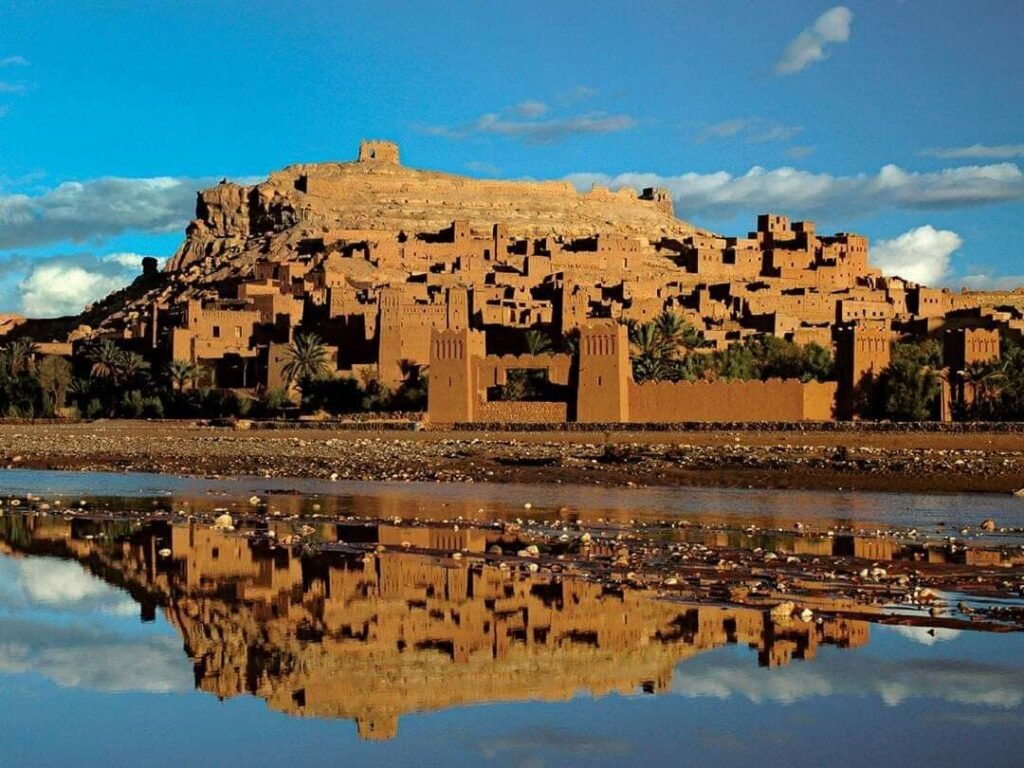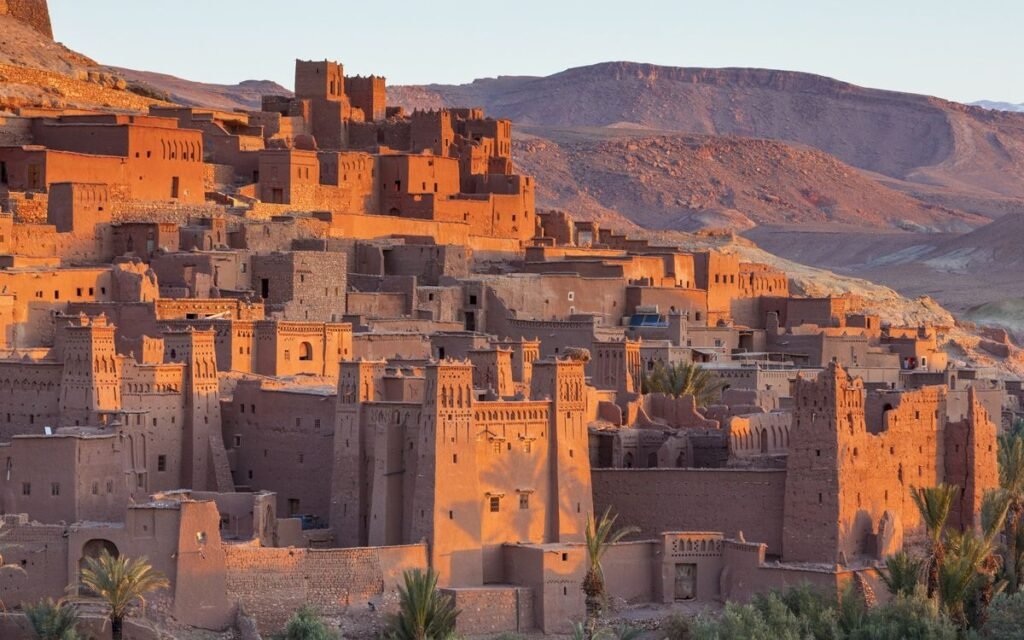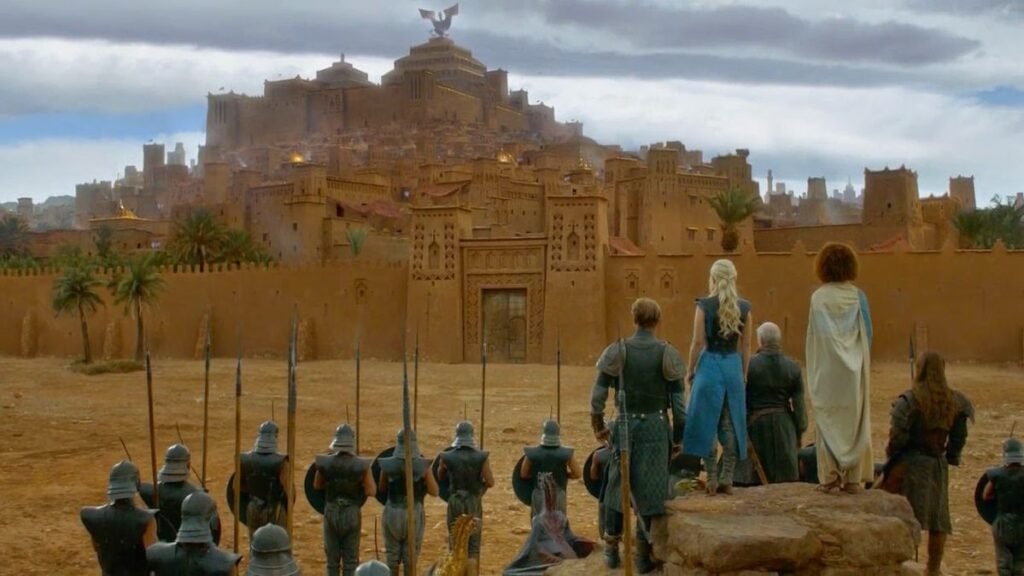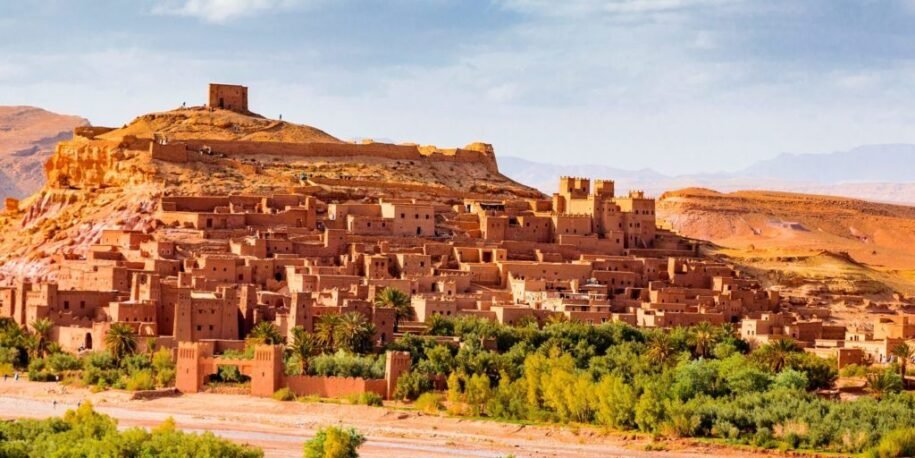Kasbah Ait Ben Haddou is one of the most fascinating places in Morocco. It is a traditional mudbrick village that has stood for centuries. Located in southern Morocco, near the city of Ouarzazate, this ancient ksar (fortified village) is a UNESCO World Heritage Site and a popular stop for travelers who want to explore the beauty and history of Moroccan culture.
In this article, you will discover everything you need to know about Kasbah Ait Ben Haddou – its history, architecture, location, things to do, and why it’s a must-see attraction in Morocco.
Where is Ait Ben Haddou Located?
Ait Ben Haddou is located about 30 kilometers from Ouarzazate and around 180 kilometers from Marrakech. It lies along the former caravan route between the Sahara Desert and Marrakech, making it a historic stop for traders.
This area is often called the “Gateway to the Sahara” and is surrounded by stunning desert landscapes, palm groves, and the Atlas Mountains in the distance.
Is Ait Ben Haddou Worth Visiting?

Yes, absolutely! If you are planning a trip to Morocco, Ait Ben Haddou should be on your list. It’s not only beautiful and peaceful, but it also gives you a true taste of Moroccan heritage. Walking through the narrow lanes, seeing the mudbrick homes, and climbing to the top for panoramic views feels like stepping back in time.
Here’s why it’s worth it:
- Stunning views of the desert and river
- Rich history going back to the 11th century
- Unique Berber architecture
- Filming location of many famous movies
- Warm, welcoming local people
History of Kasbah Ait Ben Haddou
The village dates back to the 11th century. It was an important trading post on the trans-Saharan caravan route. Traders from the Sahara would pass through with gold, salt, and spices on their way to cities like Marrakech.
During the 17th century, Ait Ben Haddou was at its most powerful. Its strong walls and towers protected it from enemies, while its central location allowed it to thrive as a hub of commerce and culture.
Today, though fewer people live inside the old kasbah, it still stands strong, representing the resilience and creativity of Morocco’s builders.
What is the Architecture Like?

The architecture of Ait Ben Haddou is one of its most special features. The village is made mostly from mudbrick, a mixture of earth, water, and straw. This type of building material is perfect for the hot and dry desert climate.
The village includes:
- Tall defensive walls
- Towers with decorative patterns
- Granaries and storehouses
- Homes built into hillsides
- A small mosque and cemetery
Walking through the village feels like walking through a movie set, but everything is real and historical.
UNESCO World Heritage Site
In 1987, Kasbah Ait Ben Haddou was named a UNESCO World Heritage Site. This helped protect the village from being lost to time. Many parts of the kasbah have been carefully restored, using traditional materials and methods.
Today, sustainable tourism and preservation projects help maintain the site, ensuring that future generations can enjoy this architectural treasure.
Ait Ben Haddou in Movies and TV Shows

One of the main reasons many tourists visit Ait Ben Haddou is because it has been featured in many famous films and TV shows. The dramatic landscapes and ancient look make it a favorite for filmmakers.
Here are just a few of the productions filmed here:
- Gladiator
- The Mummy
- Prince of Persia: The Sands of Time
- Kingdom of Heaven
- Game of Thrones (as the city of Yunkai)
If you love movies, you will enjoy recognizing scenes as you walk around the village.
What to Do in Ait Ben Haddou
There are many things to do when you visit Ait Ben Haddou. It is not just a place to take pictures. It is a place to explore, learn, and connect with Moroccan culture.
Here are some great activities:
1. Take a Guided Tour
A local guide can tell you stories about the history of the village, its buildings, and its people. You’ll learn about the Berber lifestyle and the importance of the kasbah.
2. Climb to the Top
At the top of the village, there’s a fortress with breathtaking views of the desert and the Ounila River. Sunset from here is especially beautiful.
3. Visit Local Shops
Buy handmade Berber crafts, carpets, jewelry, and pottery. Many locals sell souvenirs that make perfect gifts and help support the community.
4. Enjoy Moroccan Food
Try traditional dishes like:
- Chicken or lamb tagine
- Couscous
- Mint tea
There are small cafes and restaurants where you can relax and enjoy the view.
When is the Best Time to Visit Ait Ben Haddou?
The best time to visit is during:
- Spring (March–May)
- Autumn (September–November)
During these times, the weather is pleasant – not too hot or too cold. Summer can be very hot, with temperatures above 40°C (104°F), and winter nights can be cold, especially in the desert.
How to Get to Ait Ben Haddou from Marrakech
You can reach Ait Ben Haddou from Marrakech in about 3.5 to 4 hours by car.
Ways to Get There:
- Private car: Comfortable and allows for stops on the way
- Tour group: Many desert tours from Marrakech include Ait Ben Haddou
- Bus to Ouarzazate, then a taxi
Driving from Marrakech takes you through the High Atlas Mountains and gives you beautiful views and photo spots.
Tours from Marrakech to Ait Ben Haddou
Many visitors choose to book desert tours from Marrakech. These tours often include:
- A visit to Ait Ben Haddou
- Ouarzazate and the Atlas Studios
- A night in a desert camp in Merzouga or Zagora
- Camel rides and sunset views over the dunes
Companies like Morocco Dream Safari offer trusted and well-organized tours for all types of travelers.
What’s Nearby Ait Ben Haddou?
If you have more time, explore these nearby places:
- Ouarzazate: Known as the Hollywood of Africa, home to Atlas Studios
- Telouet Kasbah: A beautiful and lesser-known kasbah in the Atlas Mountains
- Skoura Palm Grove: A peaceful oasis with more kasbahs and palm trees
- Todra Gorge: A dramatic canyon perfect for hiking and climbing
Tips for Visiting Ait Ben Haddou
- Wear comfortable shoes – the streets are uneven and uphill.
- Bring water – it can get hot, especially in summer.
- Dress modestly – Morocco is a conservative country.
- Respect the site – it’s a living village and a heritage location.
- Take your time – explore slowly and enjoy the atmosphere.
Conclusion
Kasbah Ait Ben Haddou is not just a place to visit; it’s a place to experience. Its rich history, amazing architecture, and movie magic make it one of the top destinations in Morocco.
Whether you are a fan of culture, history, or cinema, this ancient village will leave you with unforgettable memories. From the winding paths to the sunset views, every moment in Ait Ben Haddou is special.
So pack your bags, plan your trip, and get ready to walk through Moroccan history at Kasbah Ait Ben Haddou.
FAQs About Ait Ben Haddou
What is Ait Ben Haddou known for?
It is famous for its mudbrick architecture, UNESCO World Heritage status, and being a filming location for many Hollywood movies.
Is Ait Ben Haddou still inhabited?
Yes, a few Berber families still live in the old village, while most have moved to the new town across the river.
What is the difference between a kasbah and a ksar?
A kasbah is a single fortress or castle, while a ksar is a group of buildings, like a village, enclosed by walls.
Can you visit without a guide?
Yes, you can walk around on your own, but a guide can enhance your experience with interesting stories and facts.
Is Ait Ben Haddou safe?
Yes, it is very safe for tourists. Locals are friendly and used to visitors from all over the world.
Ready to explore one of Morocco’s most beautiful places? Ait Ben Haddou is waiting for you!


Leave a Reply